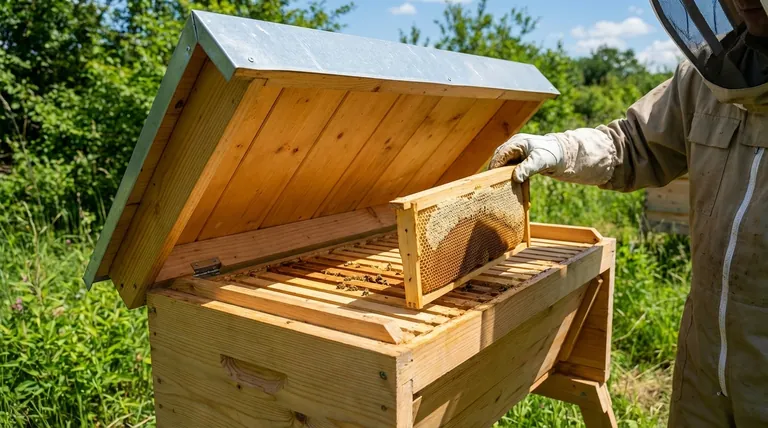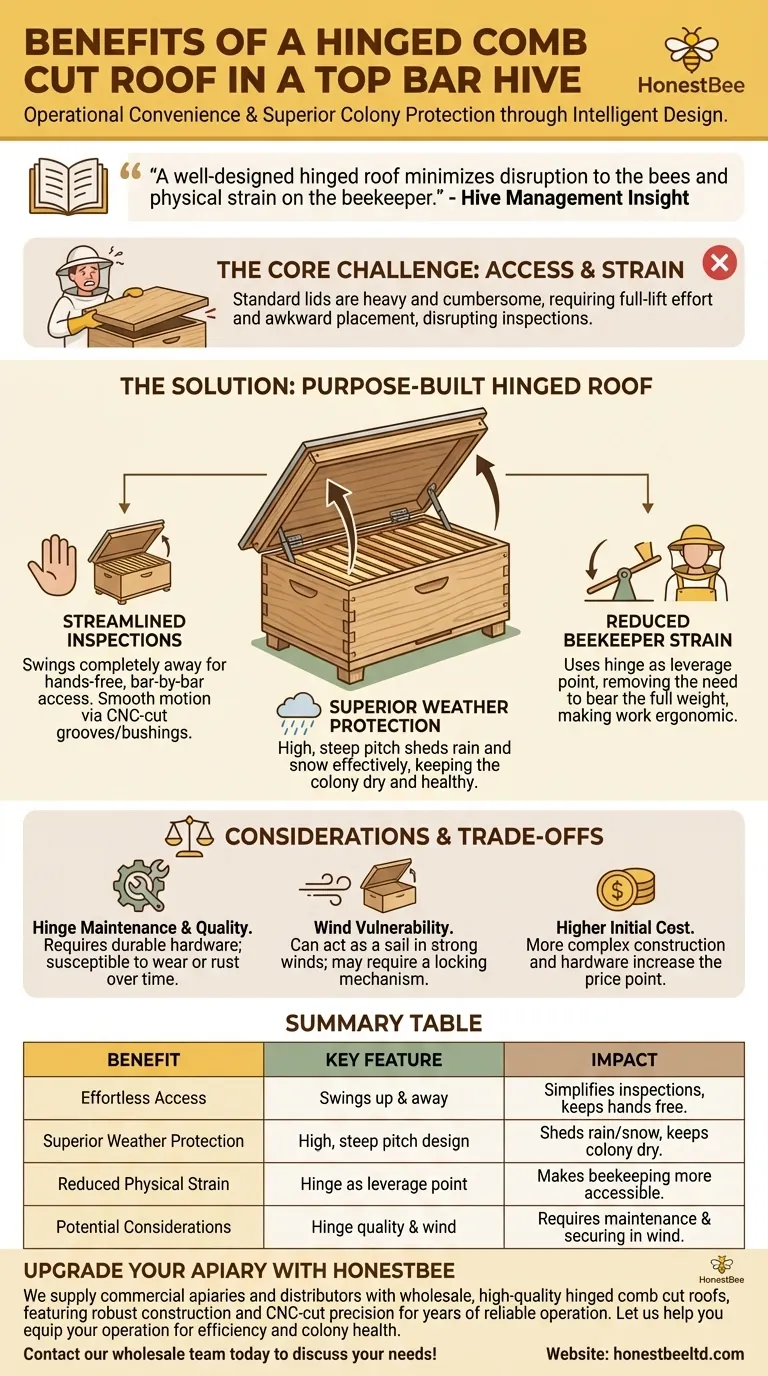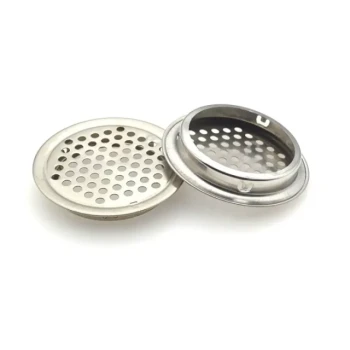At its core, a hinged roof on a top bar hive offers two primary benefits: operational convenience for the beekeeper and superior protection for the colony. This design is engineered to be easily lifted and moved completely out of the way, simplifying hive inspections and reducing physical strain. Key features often include a high pitch to shed rain effectively and robust construction to protect the bees from the elements.
The choice of a hive roof is more than just a cover; it directly impacts the ease and effectiveness of your hive management. A well-designed hinged roof minimizes disruption to the bees and physical strain on the beekeeper, making the entire process smoother and more sustainable.

The Core Challenge: Accessing the Top Bar Hive
Inspecting a top bar hive (TBH) is fundamentally different from inspecting a standard Langstroth hive. The primary goal is to remove the main barrier—the roof—with minimal effort and disruption to prepare for a bar-by-bar inspection.
Why Access Is Crucial
In a TBH, you don’t lift heavy boxes. Instead, you work from above, inspecting one comb at a time. This requires your full attention and both hands free to gently handle the fragile, foundationless combs.
A cumbersome roof complicates this entire process. If the lid is heavy, awkward, or has no designated place to rest, the beekeeper can feel rushed or strained, leading to less thorough inspections.
The Problem with Basic Lids
Many basic hive plans use a simple, heavy lid that rests directly on the top bars. While functional, this design requires you to lift the entire weight of the roof and find a clean, stable place to set it down during your inspection.
This can be physically demanding and inconvenient, especially in a crowded apiary or on uneven ground.
How a Hinged Roof Solves Key Problems
A purpose-built hinged roof, sometimes called a "comb cut" roof in specific product lines, directly addresses the challenges of TBH management through intelligent design.
Streamlines Hive Inspections
The primary advantage is effortless access. A hinged roof swings up and away, often in either direction, leaving the hive body completely open and accessible.
This keeps your hands free to focus on handling the combs, not wrestling with a heavy lid. High-quality designs use features like CNC cut grooves and bushings to ensure the swinging motion is smooth and reliable for years.
Enhances Weather Protection
A roof's main job is to keep the colony dry and protected. Hinged roofs are often designed with a high, steep pitch.
This design is optimal for shedding rain and snow, preventing water from pooling and potentially leaking into the hive. This is critical for the colony's health, as dampness can lead to mold, chilled brood, and disease.
Reduces Beekeeper Strain
By using the hinge as a leverage point, the roof becomes significantly easier to lift. You are not bearing its full weight.
This ergonomic benefit makes beekeeping more accessible and enjoyable, especially for those who may have limitations with heavy lifting.
Understanding the Trade-offs
While highly beneficial, a hinged roof is not without considerations. An objective evaluation requires understanding its potential downsides.
Hinges as a Point of Failure
Any mechanical part can wear out over time. Hinges can be susceptible to rust or seizing if not properly maintained. The quality of the hardware is critical to the roof's long-term durability.
Potential for Wind Damage
An open hinged roof can act like a sail in a strong gust of wind. This can cause it to slam shut, potentially crushing bees or startling the colony. In very windy locations, you may need a way to secure the roof in its open position.
Cost and Complexity
A specialized hinged roof with quality hardware and precision cuts is almost always more expensive than a simple, non-hinged cover. Its construction is more complex, which is reflected in the price.
Making the Right Choice for Your Hive
To select the best roof, you must align its features with your specific goals, budget, and local environment.
- If your primary focus is convenience and frequent inspections: A well-built hinged roof is a superior investment that will save you time and physical effort.
- If your primary focus is budget and simplicity: A standard, non-hinged migratory or telescoping cover is perfectly functional, though it will require more effort to manage during inspections.
- If you live in a high-wind area: Carefully evaluate the hinge strength and consider if you need a mechanism to lock the roof open to prevent it from slamming shut.
Ultimately, the best equipment is what empowers you to be a more attentive and consistent beekeeper by removing barriers to managing your hive.
Summary Table:
| Benefit | Key Feature | Impact |
|---|---|---|
| Effortless Access | Swings up and away | Simplifies hive inspections, keeps hands free |
| Superior Weather Protection | High, steep pitch design | Sheds rain/snow effectively, keeps colony dry |
| Reduced Physical Strain | Uses hinge as leverage point | Makes beekeeping more accessible and enjoyable |
| Potential Considerations | Hinges can wear; can be a sail in wind | Requires quality hardware; secure in windy areas |
Ready to upgrade your hive management with a durable, purpose-built hinged roof?
At HONESTBEE, we supply commercial apiaries and beekeeping equipment distributors with high-quality, wholesale-focused hive components. Our hinged comb cut roofs are designed for years of smooth, reliable operation, featuring robust construction and CNC-cut precision.
Let us help you equip your operation for greater efficiency and colony health.
Contact our wholesale team today to discuss your needs!
Visual Guide

Related Products
- Long Langstroth Style Horizontal Top Bar Hive for Wholesale
- Top Bar Beehive for Beekeeping Wholesales Kenya Top Bar Hive
- Telescopic Beehive Outer Cover Lid Roof with Galvanised Sheeting for Langstroth Hive and Beehive Outer Cover
- Professional Insulated Winter Hive Wrap for Beekeeping
- Inner Beehive Cover for Beekeeping Bee Hive Inner Cover
People Also Ask
- What are the most popular types of hives besides the Langstroth? Top Bar & Horizontal Hives Explained
- What is a top bar bee hive? A Natural, Low-Stress Beekeeping Solution
- What are the benefits of the top bar hive? A Guide to Ergonomic, Natural Beekeeping
- What are the box management requirements for a top bar hive vs. Langstroth? Choose Your Hive Strategy
- How does the top bar hive help control varroa mites? A Natural Approach to Mite Management



















